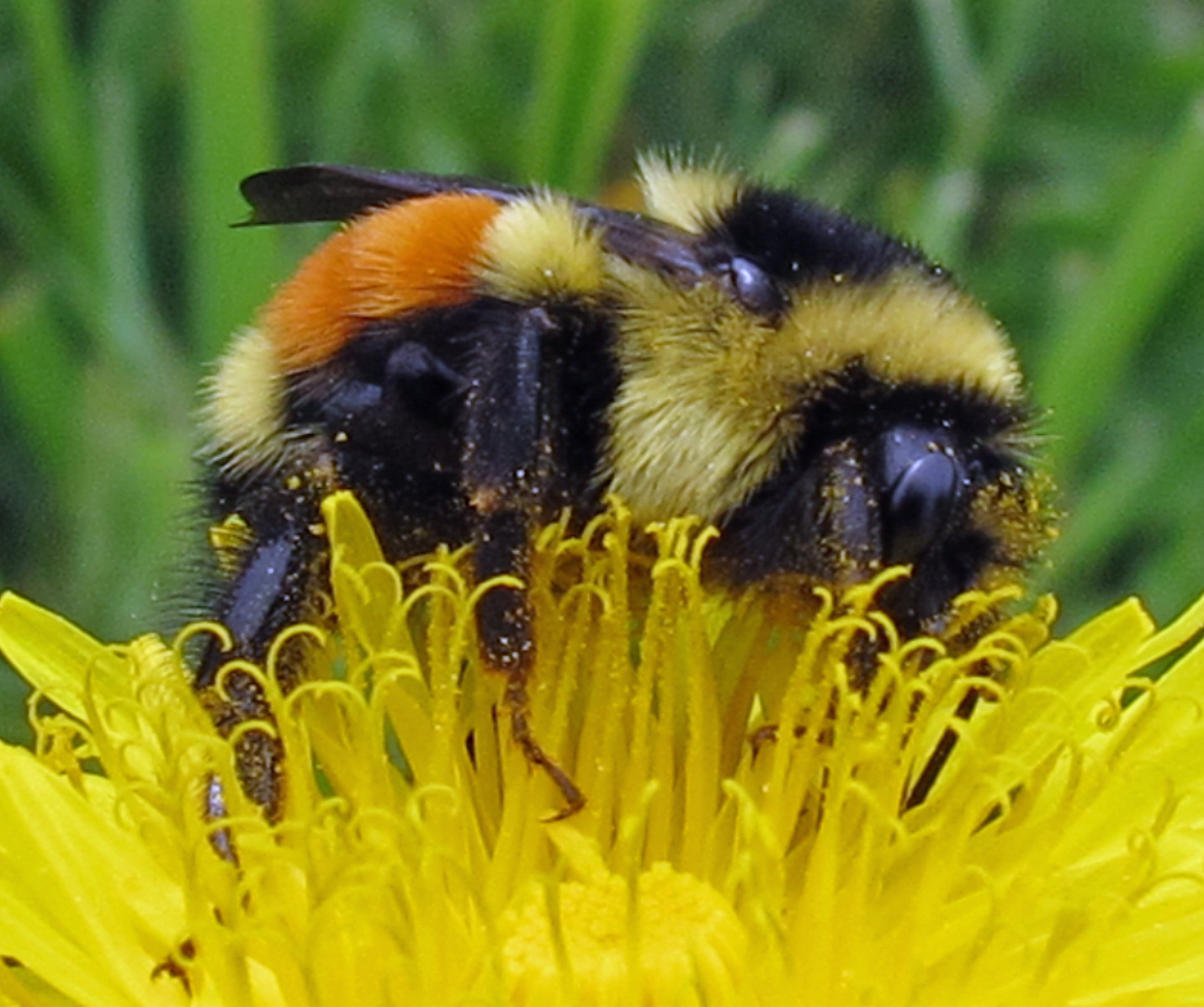I’ve always discounted bees as nuisances, little demons wanting to sting me. My closest encounters have been with bumblebees and sweat bees, but there are between 300 and 400 different species of bees in Iowa alone. Worldwide the number of species is in the ten thousands. Bees branched off from wasps some 120 million years ago, about the time that flowering plants evolved on earth. Since then, bees have become vegetarians, focusing on nectar and pollen while wasps continued their predatory ways. The interdependence of bees and flowers evolved to the point that, today, if bees are not available to pollinate flowers, there will be no cherries, no apples, no almonds, no squash, no roses, no seeds. Only the wind-pollinated species will survive.
Honeybees, imported from Europe, are, of course, used commercially to pollinate various crops. On Owl Acres, it’s the native bees that do all the pollinating. Let’s take a look at one of the most common groups of Iowa bees—bumblebees.
There are over 250 different species of bumblebees worldwide. Although there are differences among these species, they all share common characteristics. Bumblebees are the only native bees considered to be social. That is, they live in colonies of up to 150 worker bees with a single queen. The queens build their nests in abandoned rodent burrows, leaf litter, brush piles and native bunchgrasses. In the spring, a queen bee comes out of hibernation and begins laying eggs to build her colony. Almost all of her offspring will be female worker bees. These worker bees will forage for pollen which they will bring back to the nest, and nectar, which they eat. They don’t build up reserves of honey like the honeybees, because they don’t maintain the colony through the winter. By fall, the queen has created young queens who leave the nest to mate. The new queens with their cargoes of fertilized eggs find a place to hibernate through the winter while the rest of the colony perishes. In the spring the young queens begin building a new nest and start the cycle over again. While European honeybees maintain the same hive for multiple years, the bumblebees start new colonies each spring.
Bumblebees (Bombus spp.) are large, sturdy-bodied fuzzy or furry-looking bees between half an inch and an inch long. They’re usually black and yellow in color, although some species have other coloration. Their bodies and legs are hairy. The abdomen and thorax are round while the legs are relatively wide and flat. Like other insects, they have two pairs of wings and six legs. On either side, the front and back wings are held together with a series of hooks. This makes them look like they only have two wings. Those wings can vibrate 130 to 240 times per second, creating that familiar buzz. Bumblebees have baskets made of stiffened hairs on their rear legs that they use to carry pollen back to the nest to feed the larvae.
Bumblebees are said to be docile, attacking only when threatened. They can sting more than once because they don’t leave their stingers in their victims. Only female worker bees can sting because the stinger is actually an adaptation of the ovipositor, an egg-laying structure that sterile worker bees don’t need.
Bumblebees are crucial pollinators on owl Acres. They emerge in early spring with the first blossoms and continue their work through the summer and into the fall, gathering nectar and pollen, and thus pollinating, whatever flowers are in season. As native species themselves, Iowa’s bumblebees prefer native plants for their food. They are unusual in their ability to pollinate greenhouse crops, however, and have been commercially bred for this purpose. Bumblebees have a unique way of buzz-pollinating. They latch onto the pollen-producing anthers inside the flower and use their wing muscles to vibrate the pollen loose from the anthers. This is particularly helpful in tomato, pepper and cranberry plants where the pollen is closely adhered to the anthers. The hairs that make them look fuzzy catch the pollen as it rains down. They can also use this vibrating technique to “shiver” themselves warmer on cold spring days, or when the queen is brooding her first batch of eggs and needs to keep them warm.
Of the approximately 50 species of bumblebees in North America, several are considered endangered, including four species found in Iowa. Of these, the rusty patch bumblebee was the first to go on the endangered species list. Loss of its prairie habitat and pesticides are both reasons for its declining population. A recent analysis concludes that at least a third of bumblebee species populations in the United States are declining.
We didn’t have any cherries last year, either because of an untimely frost that killed the blossoms, or because there weren’t enough bees around to pollinate them. I hope it was the former, and that this year we’ll share cherries with the birds again.
Photo by Jacy Lucier

1 comment
Wonderful Bees! Love this!